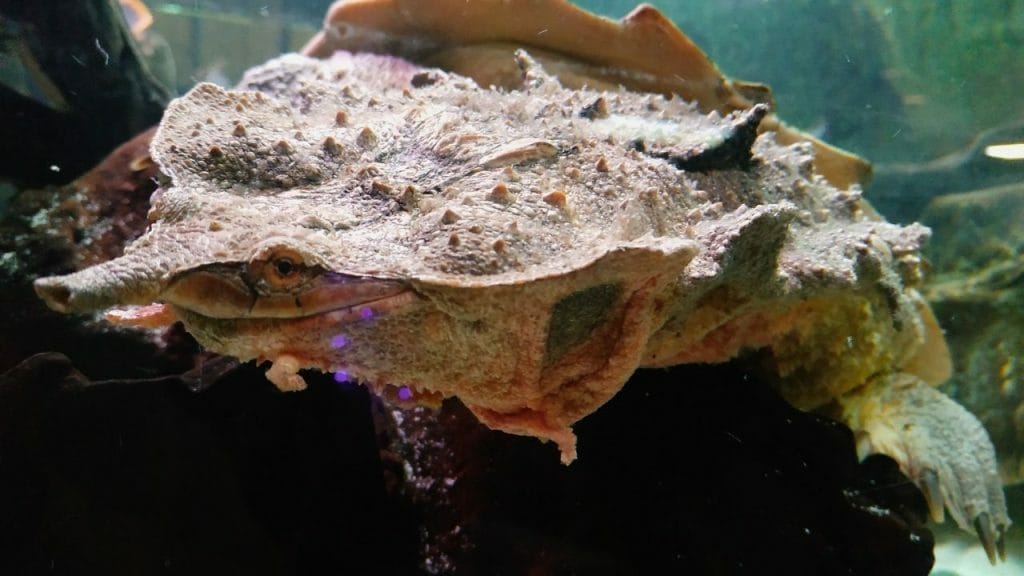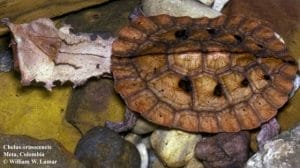Chelus fimbriata (Matamata Turtle)
Home > Turtle Database > Chelus fimbriata (Matamata Turtle)

Chelus fimbriata is a highly unique freshwater turtle species commonly known for its leaf-like appearance, camouflaging skills, and exceptional hunting techniques. Found in South America, this turtle has adapted to slow-moving waters, where it excels at ambush hunting using its natural disguise.
Native To These Regions
Amazon Basin, Orinoco BasinNative Turtle Species Map – Find Turtles by Region
Scientific Classification
- Kingdom: Animalia
- Phylum: Chordata
- Class: Reptilia
- Order: Testudines
- Family: Chelidae
- Genus: Chelus
- Species: Chelus fimbriata
Common Names
- Matamata Turtle
This Hilarious Turtle Book Might Know Your Pet Better Than You Do
Let’s be real—most turtle care guides feel like reading a textbook written by a sleep-deprived zookeeper.
This one’s not that.
Told from the snarky point of view of a grumpy, judgmental turtle, 21 Turtle Truths You’ll Never Read in a Care Guide is packed with sarcasm, sass, and surprisingly useful insights.
And hey—you don’t have to commit to the whole thing just yet.
Grab 2 free truths from the ebook and get a taste of what your turtle really thinks about your setup, your food choices, and that weird plastic palm tree.
It’s funny, it’s honest, and if you’ve ever owned a turtle who glares at you like you’re the problem—you’ll feel seen.
Identification
Description
Chelus fimbriata has a distinctive flattened, triangular head with a rough, ridged shell that mimics the appearance of bark or dead leaves. The turtle’s head is broad, with fringed skin flaps, and a long tubular snout, allowing it to breathe while staying submerged.
Sexual Dimorphism
Males typically have longer, thicker tails than females, and their plastron (underbelly) is slightly concave to aid in mating.
Check more turtles from the Chelus genus
Native Origin and Distribution
Geographical Range
Chelus fimbriata is native to the slow-moving rivers, swamps, and floodplains of the Amazon and Orinoco basins in South America, spanning across countries like Brazil, Colombia, Venezuela, and Peru.
Preferred Habitat
This species prefers shallow, slow-moving freshwater environments such as swamps, marshes, and rivers with abundant aquatic vegetation, which aids in camouflage.
Behavior
Feeding Habits
The Matamata is a carnivorous ambush predator, feeding primarily on fish. It uses its suction-like mouth to capture prey by quickly extending its neck and sucking in water along with the prey.
Predators
Adult Matamatas have few natural predators due to their size and camouflage. However, eggs and hatchlings may be vulnerable to birds, large fish, and other reptiles.
Reproduction
Breeding Season
Mating generally occurs during the rainy season when water levels are higher.
Reproductive Method
Females lay clutches of around 12–28 eggs on sandy riverbanks. The incubation period lasts about 200 days, with hatchlings emerging during the dry season.
Conservation
Extinction Status
Currently, Chelus fimbriata is listed as Least Concern by the IUCN Red List, but localized populations may face threats.
Threats
Habitat loss due to deforestation, water pollution, and illegal pet trade pose significant threats to this species.
Conservation Measures
Conservation efforts include habitat protection and regulations on the trade of wild-caught individuals.
Economic Importance
Chelus fimbriata is popular in the exotic pet trade due to its striking appearance. However, it requires specific environmental conditions, making it challenging to care for in captivity.
Interesting Facts
- The Matamata’s ability to mimic leaves and debris is so effective that it can remain virtually undetectable by both prey and predators.
- It doesn’t chew its food; instead, it uses suction feeding to swallow prey whole.
- Its name, “Matamata,” means “kill, kill” in Spanish, a reference to its hunting style.

About Author
Muntaseer Rahman started keeping pet turtles back in 2013. He also owns the largest Turtle & Tortoise Facebook community in Bangladesh. These days he is mostly active on Facebook.












